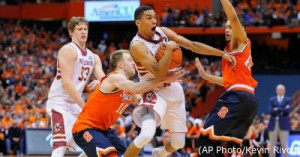
The 2013-2014 Syracuse men’s basketball season was full of extremes. There were the school-record 25 straight wins and No. 1 ranking to start the season. And then there was the 3-6 slide to end the season, which was Syracuse’s worst finish by record since the National Championship in 2003.
But winning streaks and late-season nosedives weren’t the only extremes SU demonstrated last year. Here is a look at what made those Orange unlike any other before them and why the 2014-2015 Orange will be different.

If there was one thing that stuck out when you watched last year’s team, it was the painstakingly slow pace of games. According to Ken Pomeroy’s adjusted tempo rating, SU averaged 61.3 possessions per 40 minutes. This is not only Syracuse’s slowest tempo in the last 13 years – by a lot – but it also ranked the Orange 343rd out of 351 Division 1 teams.
» Related: Will Trevor Cooney continue to improve?
A benefit of this style of play was that it minimized turnovers. Last year’s team, led by Tyler Ennis, turned the ball over on just 14.8 percent of possessions, better than any SU team in at least 13 years.
Next year’s Orange will play faster and looser out of necessity. Incoming freshman point guard Kaleb Joseph will take the reigns from Ennis. This is like replacing Princess Peach with Donkey Kong in Mario Kart – slow and steady to high risk, high reward.
Gone will be Ennis’s methodical play that limited turnovers and kept scores in the 50s. Instead, Joseph will use his speed and athleticism to push the tempo and run fast breaks.
Joseph will also help to reverse another of last season’s extremes – the lack of assists. It may come as a surprise given Ennis’s reputation as a floor general, but Syracuse assisted just 49.1 percent of its field goals last season, the only SU team in the last 13 years to fall below 50 percent.
While running the break will help rack up assists, a bigger factor is that Syracuse no longer has the personnel to run isolation plays. Last season, the offense often consisted of getting the ball to CJ Fair and letting him play one-on-one. While this was often effective, it doesn’t result in many assists in the box score.
The styles of play of Tyler Roberson and incoming freshman forward Chris McCollough are not as well suited for one-on-one play. Instead, the Orange will use more high-ball screens and dribble-drives in the half court to free up the forwards, resulting in more assisted baskets.
» Related: Chris McCullough tells Syracuse fans to expect a lot of dunks
Playing an up-tempo style and minimizing isolation plays will also help the Orange shoot a higher percentage from the field. The Orange’s effective field goal percentage, which takes into account both 3s and 2s, was just 48.2 percent last season. Once again, this was the lowest level in 13 years.
Sadly, the changes to the Orange offense are not all rosy. Last season, SU shot a very un-Syracuse-like 70.8 percent from the free throw line – the highest level in at least 13 years. Losing Fair and Ennis will hurt in this regard, as both shot better than 72 percent from the stripe. Even Jerami Grant, who struggled to start the year, finished at 67 percent.
Players like Roberson, McCollough, and Joseph may well pick up the slack next year, but they will probably not be as extreme as last year’s team of extremes. Nonetheless, they should be even more fun to watch.
For more Syracuse coverage, Like our Facebook page and follow us @TheJuiceOnline.

